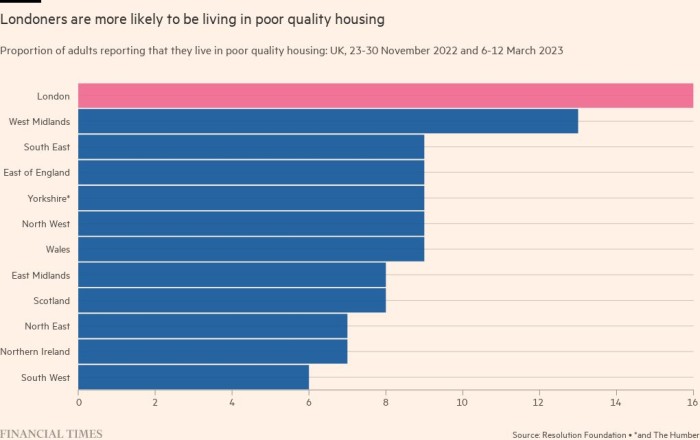A larger proportion of Londoners live in poor quality housing than in any other region of the UK, according to a report by the Resolution Foundation.
The think-tank found that 16 per cent of people in the capital were in substandard accommodation, which it defined as homes that were “not in a good state of repair, where heating, electrics or plumbing are not in good working order, and where damp is present”.
This is by far the highest level in any region and double the proportion in many other parts of the UK, including Scotland, Northern Ireland, and south-west and north-east England. The study found that nationally about 6.5mn people, roughly 10 per cent of the population, lived in poor quality housing.
“High costs and poor housing quality can make life miserable for people, and can damage both their personal finances and their wider health,” said Lalitha Try, the author of the report. Millions of people were “having to deal with damp and malfunctioning heating, plumbing and electrics”, she added.
The report, which was written in collaboration with the Health Foundation and used data from a recent YouGov survey of 10,122 adults, said the high concentration of poor quality housing in London in part reflected the high concentration of some of the most affected groups, such as young people and ethnic minorities, in the capital.
Nationally, one in six people aged 18 to 34 were found to live in poor quality housing, triple the level of those aged 45 and over, according to the report. People from Pakistani or Bangladeshi backgrounds were worst affected, with 36 per cent reporting they lived in poor quality housing, followed by black families at 25 per cent.
London is by far the wealthiest region in the UK, according to official data, but is also the area with the most expensive housing and the largest income inequality. The average house price in the capital was £534,000 in January, more than twice as much in most other regions, with affordability being the most stretched.
The research, carried out between November and March, found that those in poor quality housing were twice as likely to experience poor health as those living in better conditions. While part of the divide can be explained by socio-economic characteristics, such as age, gender, family type, or housing tenure, the report found a large health gap still remained once those were stripped out.
The report also found that 15 per cent of social renters had fallen behind on their housing costs over the past three months, compared with only 4 per cent of homeowners with mortgages. But it warned that “picture could change” as borrowers were forced to refinance at higher rates.
